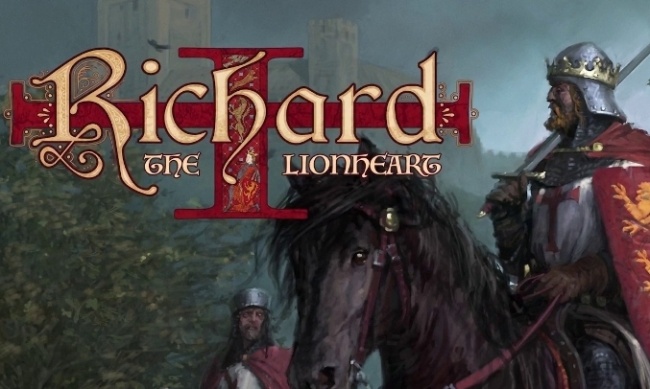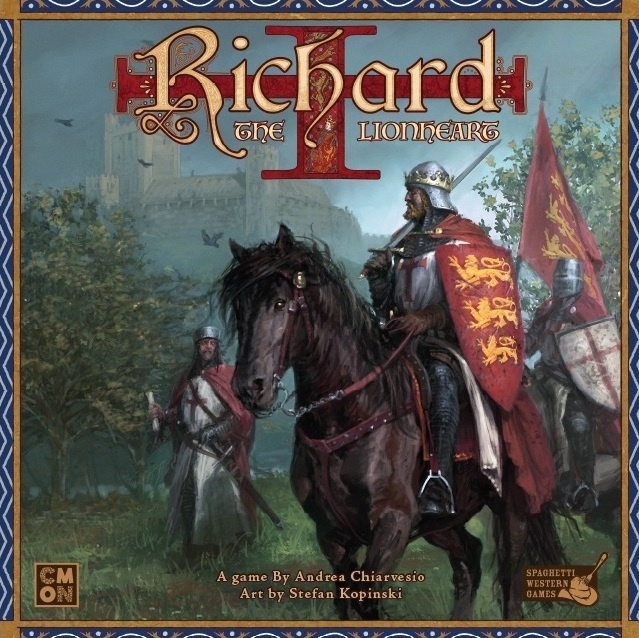Richard the Lionheart
Publisher: CMON
Release Date: November 2017
Price: $69.99
Game Designer: Andrea Chiarvesio
Format: Card/Board Game
Number of Players: 2 to 6
Playing Time: 60 minutes
Product #: RTL001
Age Rating: 14+
ICv2 Rating: 3.5 Stars out of 5
Imagine a strategic game based on a Robin Hood movie. Richard is away fighting in the Crusades, but the game takes place in England, and features Prince John, the Sheriff of Nottingham, Robin and his associates, and a few historical/legendary characters. Each player chooses one from their faction, so you might be playing as Prince John or Maid Marion, Friar Tuck or the Bishop of Ely. Players try to help Richard’s efforts or hinder them, depending on which faction they support. Players are evenly divided, but if you have 3 or 5 players, things get a little more complicated, with the inclusion of specific historical figures as neutrals, Leopold of Austria or Marie of France.
The components are detailed and attractive. The player markers and the scoring markers are individual detailed plastic miniature figures. In larger games, Merchant and Mercenary figures are added to the board, moving around to create bonuses for characters who meet up with them. The only components needing improvement are the Prestige Point tokens, which are dull purple and dull brown. The map is very nice, clear and easy to read, but you will need to refer to the town chart in the rules a lot for your first few games, to understand the action symbols.
The chart for each character has very nice art, but the bulk of the cards use art that is more generically medieval. That’s not bad, because the images are clear in their intent. Even for gamers with trouble distinguishing color, the cards for the two factions are visually distinct.
The game has some interesting strengths, including the Crusade Deck. Each turn players contribute cards from their hands into a small deck, and cards are drawn from that deck to determine what’s going on with Richard. The cards are faction-based, so which side gets the most cards in each of three categories determines that turn’s results. The down side is that there is luck of card draw to your hand, then skill in planning what cards to play, and then luck of the draw from the cards played with that skill. This double-dose of luck can lead to frustration, and sometimes a very short game. The military track, especially, can have wild swings on any given turn, and if that happens once or twice, the game will be greatly shortened.
The actions that players take while moving around the map are the way they obtain more money and/or more cards. The different towns have aligned themselves with either Richard or John, and in most cases the faction they favor gets more benefit from going there. Players often need to choose between gaining cards, money or prestige, but all are needed. After the movement actions, each player can make one purchase of advantages, cards or points. One action and one purchase per turn, with no more than 10 turns, limits your options.
Edicts and Events alter the flow of the game, the latter changing the results of a turn and the former changing the end-game scoring.
If three or five players are in the game, one player is a neutral. This neutral player creates the most headaches, both for the factions and the players. The end-game and victory rules related to the neutral player are vague, and there are at least two ways to interpret them. The way that conflicts with the fewest other rules seems to make the neutral player very powerful, though.
There are other minor rules puzzles, including what you’re supposed to do after going through the provisions deck. It’s easy to figure out a fix, but it would have been nice to have the rule clarified in the rule book.
In any case, the game is well-balanced and interesting if played with 2, 4 or 6 players, but potentially less so with 3 or 5, depending on the real meaning of the neutral player rules.
Players willing to figure out the few rules glitches or hope for an FAQ will find an enjoyable game that sometimes succumbs to swings of luck. Skill does matter in the play of the game, and determines your point score, but not always whether you’re on the winning faction. For a 4-6 player game, the 60-minute length is optimistic, but the game rarely drags.
--Nick Smith: Library Technician, Community Services, for the Pasadena Public Library in California.

ICv2 Stars: 3.5 (out of 5)
Posted by Nick Smith on November 29, 2017 @ 2:17 am CT



